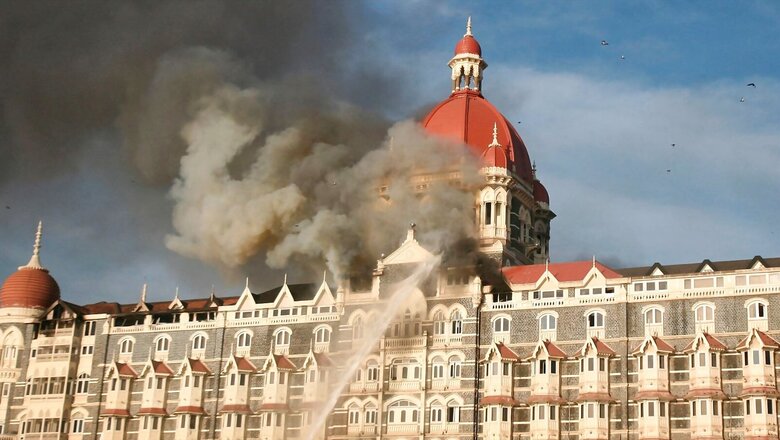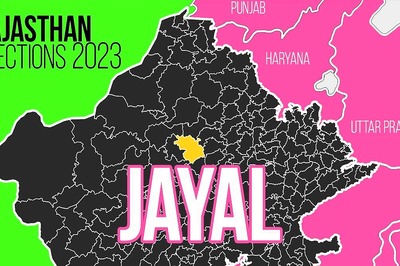
views
Nine-year-old Devika Rotawan was excited about her trip to Pune. She was to meet her elder brother there. On the evening of November 26, 2008, she, along with her family, reached Mumbai’s Chhatrapati Shivaji Maharaj Terminus (CSMT). While waiting at the station’s 12 and 13 number platform, as Devika clearly remembers, little did the family know what was to happen next.
A bomb exploded suddenly, she says. Then, indiscriminate firing followed. Devika’s siblings accompanying her ran in the other direction. Chaos ensued. Before she could realise what was happening, the nine-year-old was shot in her right leg.
10 members of Lashkar-e-Taiba, a Pakistani terror outfit, went on a rampage in India’s financial capital for over 72 hours. 166 people were killed and more than 300 were injured. Eight key locations in south Mumbai — CSMT station, The Taj Mahal Palace Hotel, Oberoi Trident, Cafe Leopold, Cama Hospital, Nariman House, Metro Cinema, and a lane next to St Xavier’s College — were targeted as the terrorists snuck into the city through its coast.
The last memory of Devika, now 23 years old and in her final year of graduation, before losing consciousness, was this: “I saw a man with a big gun in his hand firing indiscriminately at people. A lot of people were shot around me, somebody in the hands, somebody in the leg. I saw a smile on that man’s (terrorist) face. It was as if he was enjoying shooting at us,” she told News18.com
The man was Ajmal Kasab, one of the terrorists, who was later caught alive. Eventually, Devika, then 10, went on to become the youngest witness to identify Kasab which led to his conviction. Kasab was hanged almost four years later in Pune’s Yerawada prison on November 21, 2012.
Since the fateful night, Devika’s family life has turned upside down. She underwent six operations before fully recovering and being able to walk normally. Her father and two brothers had to make hectic trips to court for regular hearings. She had lost her mother two years prior to the attack.
More misery piled up. No school was ready to admit her. “The principal said if you come here, a bomb blast will happen,” Devika says. Once she found a school, she had to put up with her classmates and people in her locality teasing her with Kasab’s name.
“Long back, they used to call me Kasab ki beti (Kasab’s daughter). Then it was just ‘Kasab, Kasab’,” Devika says.
She also adds that her relatives had begun avoiding her family. It was only recently that they accepted the past, including Devika’s high-profile image while she testified in court, and began inviting them to family functions.
MANY WOUNDS, CITY’S UNITY STILL INTACT
The 26/11 terror attacks in Mumbai went on to become both one of the deadliest attacks India had witnessed in recent years and the darkest time for the city.
Mumbai (Bombay, as it was called then) had also witnessed the 1993 bombings — 12 blasts across the city orchestrated by gangster Dawood Ibrahim that left 257 people dead and 1,400 injured — and a series of train blasts in 2006.
Yet, the 26/11 attacks stand out — purely for the scale and the manner in which the city was paralysed.
Adrian Levy, journalist and co-author of The Siege: 68 Hours Inside The Taj Hotel, calls the nature of the attacks “a devil’s innovation”.
“The remote controlling 10 gunmen (from Pakistan), through internet-enabled telephone lines which described where the gunmen were actually based, the use of 24×7 cable news footage to determine the effectiveness of those gunmen — all of this make it a horrendous, notorious and remarkable event,” Levy tells News18.com
The attacks have now become a part of the city’s history and culture, he adds. “The city (Mumbai) fought back and saved itself. It had the ability to survive. That’s one of the remarkable things about Mumbai. It reflects in the entrepreneurial nature of the people of Mumbai and their ability to improvise and get out of the situation,” he says.
NIGHTMARE AT TAJ HOTEL
Entrepreneur Ankur Chawla calls himself “an out-and-out Delhi guy”. He was about 23 years old in 2008 when he was posted as a management trainee at the Taj Mahal Palace Hotel, three months prior to the carnage.
On the day the attacks began, a task given to him by his boss meant he had to stay at work till late.
“The Harbour Bar (a lounge bar in Taj where Chawla worked) starts getting busy in the later part of the evening. I remember chit-chatting with a guy who had a political background, very close to the gate of the bar. Suddenly, I heard a couple of gunshots. Normally, when you are not sure of what a gunshot sounds like, because you’ve never heard, you don’t realise it’s a gunshot,” Chawla tells News18.com.
Ankur recollects the initial rumours flying around that two guests were involved in a fight, which turned violent. Other guests panicked. Frantic calls among all employees followed. It was much later that the picture became clear.
Chawla spent the night, after realising there was no manager around then, taking guests to different locations in the hotel. From learning about the death of his colleagues, who were with him minutes ago, to lying to his parents back home that everything was fine and also calming the panic-stricken guests in a safe chamber of the hotel — it was like a dreadful dream.
He was rescued by the NSG commandos eventually, exhausted after hiding for hours under dirty linen and a pile of clothes.
A WATERSHED MOMENT
The attacks of 26/11 reignited the debate on fighting terrorism on Indian soil. The UPA government under Prime Minister Manmohan Singh came under severe scrutiny for the intelligence lapse.
Although the nation hasn’t seen a major terror attack since then, except for Jammu and Kashmir, Indians still remain wary of the threat.
A survey conducted by the US-based Pew Research Centre in 2018, a decade after the attack, showed 65% of Indians thought terrorism was a big problem. Further, 59% believed terrorism was “much worse”. This concern was in line with their views on Pakistan. 76% believed the neighbouring country posed a threat, including 63% who said it was a “very serious threat”.
National security adviser at the time MK Narayanan admitted in 2014 that the intelligence agencies had sufficient inputs to anticipate an attack of this kind.
“The real failure on our part was to assess in what form the attack would take place,” he said.
Analysts believe it was a milestone for revamping the intelligence agencies.
“After that (attacks), there was a concerted attempt at trying to revamp and have better coordination at all levels, especially at the highest level of analysis. There was a JIC (Joint Intelligence Committee) that was reactivated, or re-energised I would say. There was an attempt to establish a NATGRID (a coherent intelligence database for all agencies for the use of counter-terrorism) by the UPA2,” Nitin Gokhale, national security analyst, tells News18.com.
He adds that the efforts bore fruit even more post-2014, when Narendra Modi came to power, saying the government foiled several attempts in the past eight years.
The Modi government has been hailed for its “zero-tolerance policy on terrorism”. The Centre said in Parliament this year that there has been a “substantial decrease in attacks from 2018 to 2021”, citing the example of Jammu and Kashmir.
For survivors, the memories of that dreadful night still haunt them, but they sound confident about fighting any challenge. Devika aspires to be an IPS officer and take care of her ailing family. This is at a time when she’s been engaged in a legal battle with the Maharashtra government over getting a house as part of compensation.
The state government told the court earlier this year that it can’t provide anything more than monetary aid to the survivors.
Ankur, on the other hand, penned a book that came out a few years after the carnage. He firmly believes the attacks changed his perspective towards life. While he admits there are moments when he is afraid to stay alone, fearing another terror strike, he has no qualms admitting that 14 years on, the experience has taught him to live and enjoy the present to its fullest.
Read all the Latest India News here
















Comments
0 comment